
The Delaware and Hudson Railroad Lightning stripe endures on only two units and Michael Berry shot one of them D&H GP38-2 7304 in Mid-January 2016 in Montreal, QC.
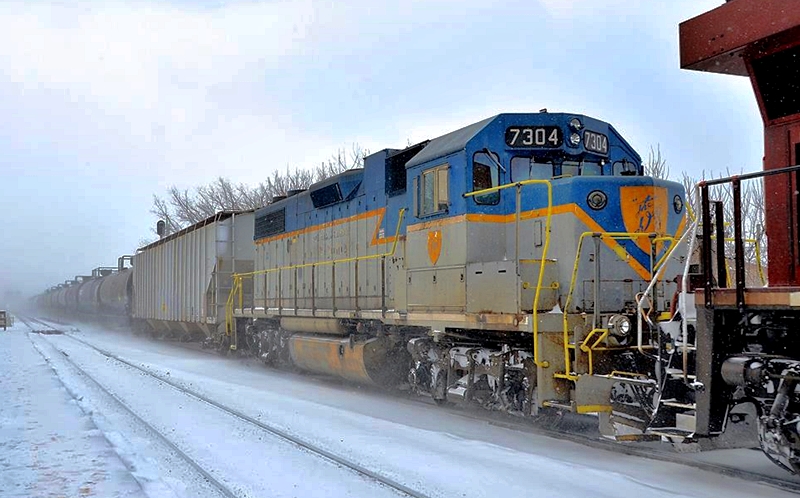
Our alternate February CRO cover photo: On the CSX Pittsburgh Sub at McKeesport, Pennsylvania, John Puda snapped dramatic shot of CP SD60 6242 leading the pair of Canadian visitors on CSX train Q388 east as they cross over the Youghiogheny River on the first day of 2016.
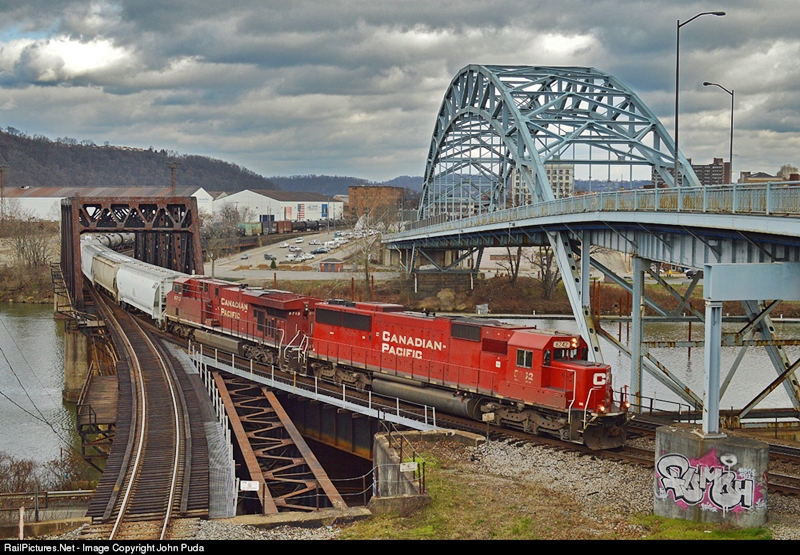
Our February CRO cover photo: Montreal Maine & Atlantic, #2, Frontenac, Quebec. Three years ago on this day, Montreal Maine & Atlantic #1 is approaching the Maine Border on the Moosehead Subdivision at Frontenac Quebec (Francois Jolin photo). The power is (Leased by MM&A) SOO 6022, R/C Caboose VB-4, CDAC 450 and MM&A 8553.

MOTIVE POWER NEWS
CP has over 100 GE AC4400CW's and GMD SD40-2's stored but spread out at many locations, St-Paul, Montreal, Toronto etc. As well some GP38-2 4-axle Yard power is stored. Last month almost all of the previous three-unit yard power consists were reduced to only two units.
As well, we have learned there will be an effort to sell some of the older excess 6-axle GMD power in 2016, and a possibility of including the early orders of GE AC4400CW's from the 9500-series.
The remaining seven CP's Red Barns are still on the roster, but stored (Since Oct. 31st, 2015). They are: CP 9001, 9003, 9006, 9007, 9008, 9009 and 9015. All the other CP SD40-2F's are retired/sold. CP SD40-2F 9004, 9010, 9011, 9014, 9017 and 9020-9024 were sold to Central Maine & Quebec (CMQ), in September, with the CP road numbers retained.
CP locomotives retired, declared surplus, stored or sold:
CP SD40-2F 9004, 9010, 9011, 9014, 9017 and 9020-9024 were sold to Central Maine & Quebec (CMQ) in September, with their former CP road numbers retained. The last one 9021 had arrived on the CMQ, in late October.
Ex-CP GP9u 1624 was acquired by the Aspen Crossing Railway in Mossleigh, AB, and has arrived at destination.
Ex-CP GP9u 1605 was sold to Respondek in September 2015, and was moved from Toronto to Kansas City over CP, then KC to St Louis over Norfolk Southern, then finally on the TRRA to the Port Harbor Railroad.
The lease of CP GP9u 8249 to Gardner Dam terminal terminated in September and is currently stored in Toronto. She was the last GP9u on the CP roster, and as of September 23rd, was declared Surplus, and remains for sale.
CP 8218 was sold to the Pennsylvania Northeastern RR on August 18, 2015, and arrived at her new Keystone State home on September 28th.
Fifteen GP9u's were sold to LTEX on June 26, 2015: 1532, 1547, 1555, 1560, 1585, 1590, 1597, 1604, 1633, 1634, 8200, 8220, 8231, 8239 and 8250, all have been delivered.
30 Retired CP SD40-2's were delivered to Bombardier Transportation's plant in Sahagun, Mexico for the SD30C-ECO program: CP 5648, 5729, 5742, 5776, 5787, 5793, 5827, 5843, 5844, 5924, 5940, 5944, 5947, 5948, 5963, 5964, 5967, 5981, 5982, 5998, 6004, 6006, 6021, 6026, 6058, 6076, 6078, 6604, 6615 and 6616. In January 2016 we learned another CP SD40-2 is going for ECO rebuild Ö CP 5794, The traction motors were removed from her on January 28th, at the shop in Golden, BC.
To former yard-assigned GP9uís are now listed for sale on Canadian Pacific Railway's surplus asset page; CP 1533, and CP 1559.
CP 1559: https://www8.cpr.ca/snpevweb/snp/Pages/ViewTender.aspx?tender=4329
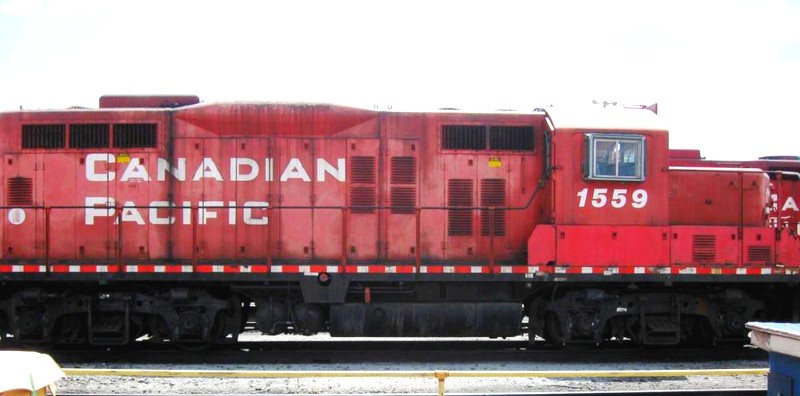
CP 1533: https://www8.cpr.ca/snpevweb/snp/Pages/ViewTender.aspx?Tender=4328
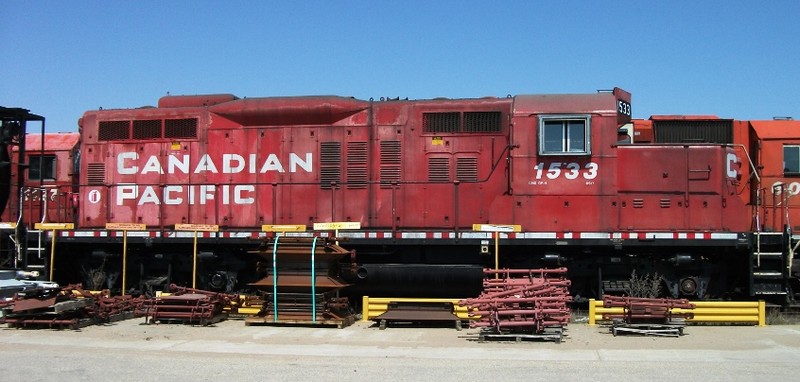
CP LOCOMOTIVE REBUILD PROGRAMS
Canadian Pacific Script-painted CP GP38-2 3084 arrived in Winnipeg, MB in November 7th for fuel tank repairs. The loco suffered a minor derailment of the unit in Scotford, Alberta (North east of Edmonton), when on AC05-30, was pulling into the spur at the SUNCOR oil facility with light engines. The lead loco (CP GP38-2 3084), came off the rails, and punctured the fuel tank.
Another CP Heritage unit, CP FP9A 1401 is still at the RELCO Shop in Albia, IA for a complete rebuild refurbishment. Once modernized, this F-unit will become what some are calling an F38A-3, which will include an EM2000 computer and its own HEP equipment.
CP GP38-2 RCL and Overhaul program:
CP is continuing to install Remote Control (R/C) equipment on a number of their GP38AC/GP38-2 units at CADRAIL (Montreal), and at NRE in Silvis, IL. Besides the GP38AC/GP38-2/SD40-2 units, Remote Control (RCL) is being implemented at the Ontario rail yards in London, Welland, and Toronto. CP is also considering applying RCL to some of their new GP20C-ECO units in CP 2200-series.
The previous program of overhauling GP38-2 and GP38AC locomotives to Tier 0+ compliance, and upgrading with AESS (Automatic Engine Start/Stop), and full CP repaint has changed with the new RCL program now paramount.
NATIONAL RAILWAY EQUIPMENT - Silvis, IL:
CP GP38-2 3083 and CP GP38-2 4443 were completed in late January complete with the new RCL system, ZTR and new cab systems, and have been released from NRE back to CP. SOO 4420 is currently in the shop being worked on as we went to press. Mt Vernon sent six electricians to help NRE with the ZTR installations on CP 3131 and CP 3132. All other CP units on the property are waiting for an opening including (ex-D&H) CP GP38-2 7311.
CADRAIL Lachine, QC:
CP 4442, 4508 and 4433 were completed in January with the new RCL system, ZTR and new cab systems, and have been released from Cadrail back to CP (St-Luc Yard).
SOO SD60 overhaul - Contract Completed:
CAD Railway Industries (Lachine, QC), completed the former SOO LINE SD60 and SD60M overhaul and repaint contract for the Canadian Pacific Railway in August 2013. The overhauls included Tier 0+ compliance, installation of AESS (Locomotive Automatic Engine Start/Stop) to conserve fuel. All are in Candy Apple Red and renumbered into the CP 6200-series, and each received (PTC) Positive Train Control modifications at the CP St-Luc Diesel Shop. They did not get any cab upgrades however.
CP SD60's and SD60M's released from CAD during 2012 and 2013: CP 6221, 6222, 6223, 6225, 6228, 6229, 6230, 6231, 6232, 6234, 6236, 6238, 6239, 6240, 6241, 6242, 6245, 6243, 6246, 6447, 6248, 6249, 6250, 6251, 6252, 6254, 6255, 6256, 6257, 6258, 6259, 6260, and 6262. All are in service, and equipped as leaders.
The SOO LINE painted SD60 Status remains the same: 6026, 6027, 6035, 6037 and 6053 in service at Dec 31.
6024, 6033 and 6044 stored unserviceable at Dec 31
GREAT CATCH! On January 24th, 2016 Michael Berry snapped one of the ex-SOO SD60's (CP 6251) on an NS run through train with CP and NS power, on CN tracks! CN 529 is an NS run through train originating in Harrisburg as NS 31T. It becomes CP 931 while on CP tracks and then CN 529 while on CN tracks. It normally has mostly NS power, but there has been an increase in CP power on it recently. Here a clean ex-SOO SD60 leads a short CN 529 (20 cars) through Montreal. This lashup was CP 6251, CP 9700 & NS 2701.
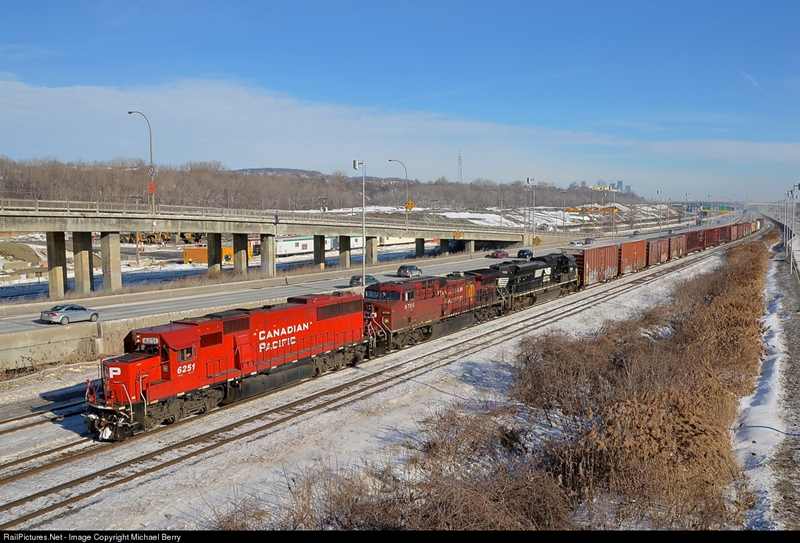
Francois Jolin caught the same train earlier from a completely different angle. Canadian National 529 heading north on the Rouses Point Subdivision at l'Acadie QC.
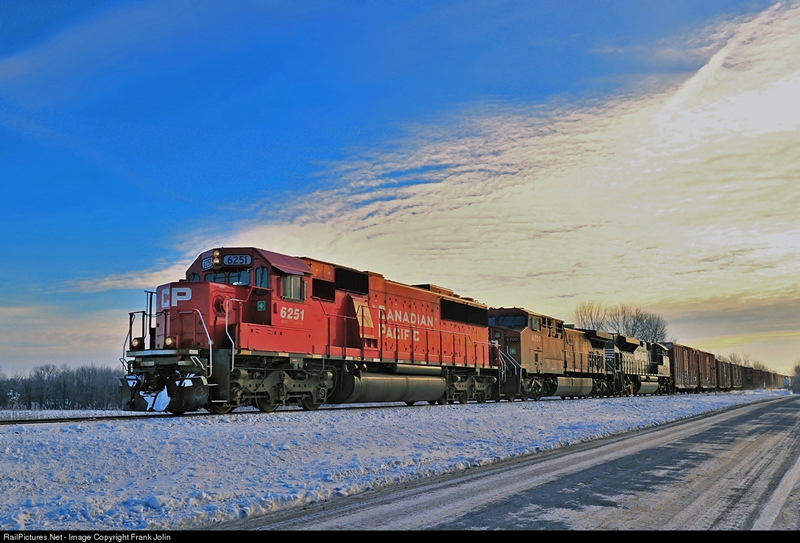
CP SD30C-ECO latest order:
CP SD30C-ECO 5030 (DRF-30aa).was shot by Gary Talsky on January 2nd, 2016 at 15:21 on Schmidt Road in West Davenport, IA.
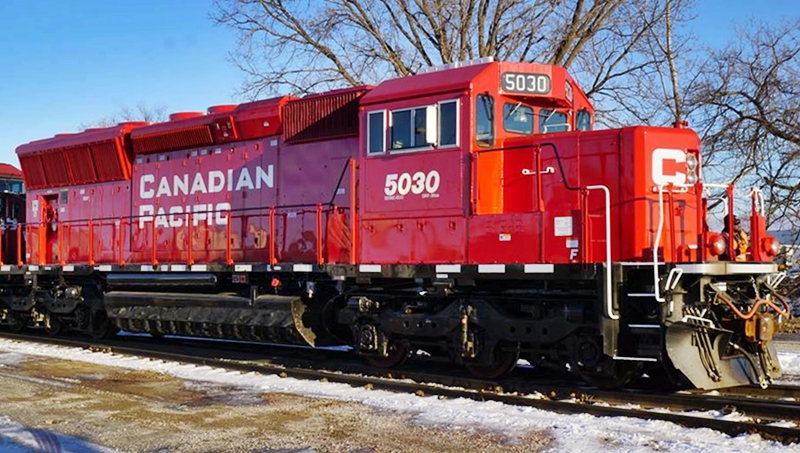
Before taking their long trek north, Juan Viladrosa snapped 5043 with her CP siblings, about to be picked up by Ferromex from the EMD Plant in Mexico (Via Hugo Garcia with thanks).
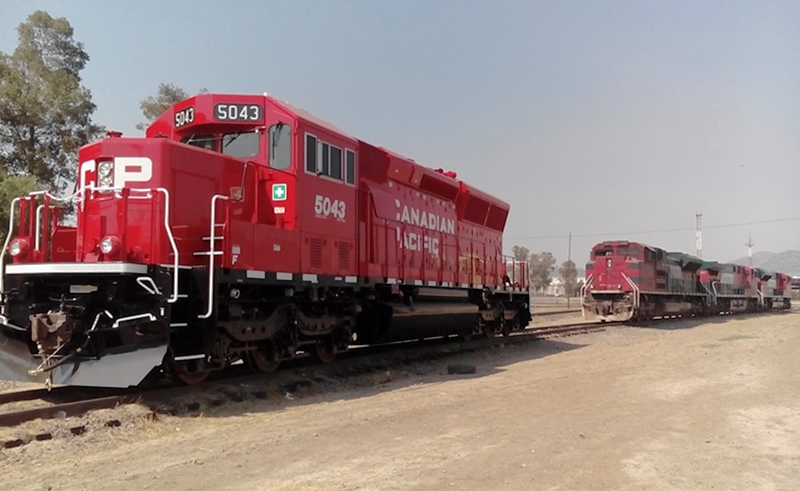
In January we learned another CP SD40-2 is going for ECO rebuild - CP 5794, The traction motors were removed from her on January 28th, at the shop in Golden, BC.
These Surplus CP SD40-2's were believed to used in the program: CP 5648, 5729, 5742, 5776, 5787, 5793, 5794, 5827, 5843, 5844, 5924, 5940, 5944, 5947, 5948, 5963, 5964, 5967, 5981, 5982, 5998, 6004, 6006, 6021, 6026, 6058, 6076, 6078, 6604, 6615, and 6616. (Note: Several were substituted and in this updated list above. More changes may take place).
The first 20 unit order of SD30C-ECO units built at EMD/Progress Rail in Mayfield, KY, was completed back in January 2014. CP 5000-5019, are all in service and since April were reassigned from Shorham Shop in St-Paul, Minnesota, to Golden B.C.
CP GP20C-ECO all three orders now completed:
CP's third order for 60 CP GP20C-ECO units (2270-2329) has been completed, with the delivery of the last units CP 2316, 2321, 2328 and 2329 arriving on January 26th, 2015 and CP 2287, on January 31st. 2015. These EMD Muncie, IN-built locomotives are brand new, with only the Blomberg trucks, and air compressor salvaged from the retired GP9u's.
The first order of 30 GP20C-ECO units
CP 2200-2229 are assigned to St. Paul, MN.
The second order has the following Canadian assigned units;
CP 2230-2249 are assigned to Alyth Yard, in Calgary, AB.
CP 2250-2269 are assigned to Toronto Yard.
The third order of GP20C-ECO units is complete, with CP 2270-2329 assigned as follows:
St. Paul, MN: 2270, 2271, 2272, 2273, 2274, 2277, 2278, 2302, 2306, 2324, 2325;
Moose Jaw, SK: 2275, 2276, 2285, 2289, 2294, 2296, 2297, 2298, 2301, 2305, 2309, 2318, 2322, 2326;
Toronto, ON: 2279, 2280, 2281, 2282, 2286, 2288, 2290, 2292, 2307, 2319;
Winnipeg, MB : 2283, 2284, 2291, 2299, 2304, 2308, 2312, 2313, 2315, 2317;
Calgary, AB: 2287, 2293, 2295, 2300, 2303, 2310, 2311, 2314, 2316, 2320, 2321, 2323, 2327.
Golden, BC: 2234, 2245, 2328 and 2329.
A video from EMD showing how a GP9u becomes a CP GP20C-ECO:
https://mail.google.com/mail/u/0/#inbox/15087c4f154a6804?projector=1
CP Leased Locomotives Roundup:
(By Bruce Chapman and Earl Roberts)
CEFX AC4400CW: 1002, 1006, 1007, 1014, 1018-1020, 1023, 1024, and 1026-1059, are all reported to be in service.
Phil Hall shot leased CEFX 1055 leading CP train 254 moves off CSX's Niagara Branch unto the Belt Line as it makes its way to Frontier Yard on November 28th 2015.
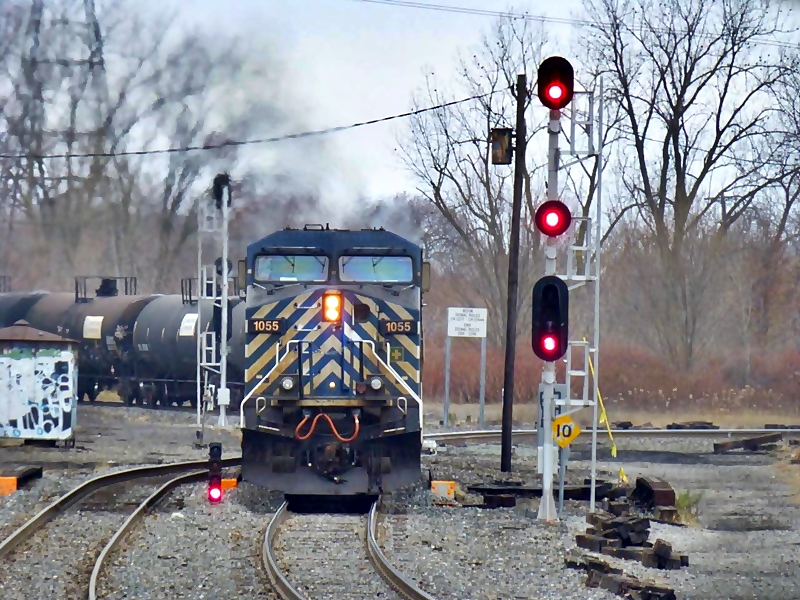
CP NEWS
More Job Cutting at CP:
The January 21st, 2016 issue of the Toronto Star reported Canadian Pacific will be cutting 1000 jobs through attrition. Given the weak economy has resulted in a drop in demand for commodity shipments, Canadian Pacific Railway said it plans to cut another 1,000 jobs this year.
CP CEO E. Hunter Harrison made the announcement during a conference call with analysts on Thursday, after reporting fourth-quarter earnings that were strong, but still fell short of analyst forecasts... Harrison took over the top job at the Calgary-based railway after a bitter proxy fight in 2012. He estimated that "6,000 to 7,000 jobs" have been eliminated to date, mostly through attrition. At the end of 2015, CP had about 13,000 employees.
Harrison also boasted that the promises made during the proxy fight have been achieved, including getting to an operating ratio of 65 per cent by 2016
CP Fourth Quarter Report:
On the January 21st, 2016, on a CP 2015 4th Quarter Conference Call; CP President and Chief Operating Officer Keith Creel noted that the company has over 600 locomotives in storage. While operating metrics were improved across the board, revenue was down from the previous year and that sparked a selloff in the stock that morning upon the release of financial numbers. CEO Hunter Harrison noted the company had decreased employment levels by 5000 to 6000 workers, over 90% through attrition such as retirements, since the 2012 proxy contest that installed a new board and management. Harrison expected a further 1000 employees to be lost to attrition through 2016 with most towards the start of the year. As far as merger talks go, Harrison said the company would have to change course although he wasn't sure what that would be with opposition from major players in the US. He said that in one case he had spoken to over 50% of the major shareholders of one company about future mergers and acquisitions.
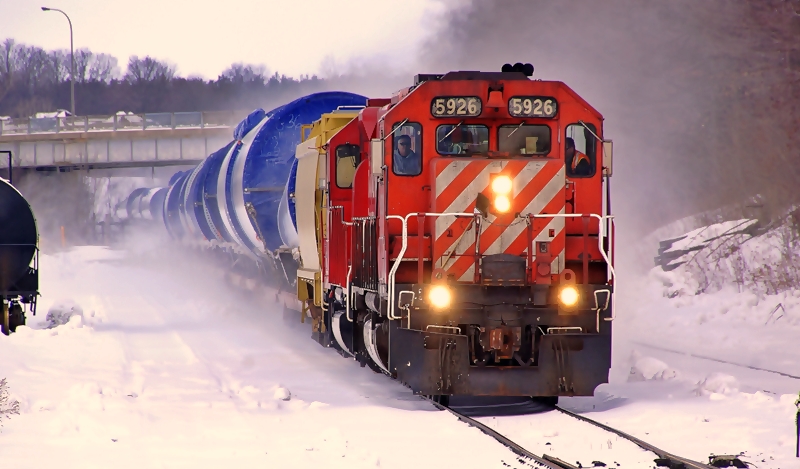
This year's CP Holiday Train a BIG Success!
For the 17th year, the Canadian Pacific Holiday Train program made its way across Canada and the northern United States, with donations expected to reach more than $1.4 million and more than 300,000 pounds of food for food banks for 2015.
"The Holiday Train is all about neighbors helping neighbors, and this year saw remarkable support for this important cause," said CP's Chief Executive Officer E. Hunter Harrison. "Each year, we are humbled by the good work local food banks do in helping those in need in their communities. We are proud that we can help them deliver on that mission."
Katharine Schmidt, executive director, Food Banks Canada, stated, "Every year, CP's train of lights provides a platform to speak about the needs of North American food banks. This year they helped drive the message home not only about ongoing needs, but the ability for individuals to raise levels of health in their community by reaching in their cupboards for healthy donations."
Overall attendance of this year's Holiday Train events was estimated at 450,000 over the 23 days. People attending, who were encouraged to think about healthy options when donating food, were entertained by a number of musicians, including Wes Mack, Kira Isabella, Doc Walker, Kelly Prescott, Jim Cuddy, Devin Cuddy, and Chic Gamine.
"We are so honored to once again be part of a magical program that brings communities together to raise money for local food banks," remarked Chris Thorsteinson of Doc Walker. "You don't realize how much towns use food banks and how important it is to support them around this time of year until you travel across the country learning about the need."
CP's annual Holiday Train program is a rolling fund-raising event that raises money, food, and awareness for food banks and hunger issues, hosting free holiday concerts along the way. Since its start in 1999, the CP Holiday Train has now helped to raise more than C$12 million and 3.9 million pounds of food for local food banks.

CP still fighting to obtain NS - now to the courts!
Canadian Pacific Railway Ltd. is asking the U.S. Justice Department to investigate whether its competitors are conspiring to block its proposed acquisition of Norfolk Southern Corp., accusing them of "unprecedented" and "likely illegal" actions. But two prominent U.S. rail lawyers say it will be a difficult case to make, and CP's rivals are likely protected from any antitrust charges. In a letter addressed to the Justice Department's antitrust division, CP argues that recent media reports indicate that its rivals are "organizing a collective campaign" to block CP's proposed takeover offer, which Norfolk Southern has repeatedly rejected.
Last week, Reuters quoted executives from CSX Corp., Union Pacific Corp. and BNSF as saying they are opposed to the proposed merger and have met to discuss it.
"We don't want Class 1 railroad mergers to happen," Union Pacific CEO Lance Fritz was quoted as saying. "We'll do everything in our power to make them not happen."
CP spokesman Marty Cej said the company only decided to ask the Justice Department to weigh in after careful consideration.
"We get it that some competitors might not like the idea of a more efficient competitor, but when statements are made in the press that others have gotten together to prevent mergers, we just thought that was eyebrow-raising," Cej said in an interview.
Michael McBride, a transportation lawyer at Van Ness Feldman LLP in Washington, D.C., said it's unlikely that CP's letter will result in its competitors being charged with antitrust violations.
"I think this is quite a long shot to expect the Justice Department to investigate this," McBride said.
"I think the Justice Department would be inclined to go after the railroads if they were collectively setting rates or terms of service, refusing to haul certain kinds of things or creating agreed-upon commercial limitations, but probably not for something like this kind of advocacy."
The Justice Department's decision will rest on its interpretation of the Noerr-Pennington doctrine, which says that private entities are immune from antitrust laws as long as they're lobbying the government.
CP says in its letter than the doctrine doesn't apply in this case, because it hasn't yet reached an agreement with Norfolk Southern or filed an application with any government agency.
But McBride said the railways' public comments are likely part and parcel of a broader advocacy effort that includes government lobbying and which would therefore be protected from any antitrust actions.
Another prominent U.S. rail lawyer said CP's letter "smacks a bit of desperation."
"This seems to me to involve potential overreaching on CP's part," said the lawyer, who agreed to speak only anonymously, as he did not want his comments to impact his practice.
In its letter to the Justice Department, CP said its competitors are more worried about what a merger will mean for their own profitability than what it will mean for the public.
"The collective communication strategy of these competitor railroads is also likely illegal because it is anticompetitive; it is an agreement to collectively work together to prohibit the introduction of competition by a new competitor, which is akin to a group boycott in principle and intended effect," it adds.
Tuesday's letter is part of an escalating war of words between CP and Norfolk Southern, with most of the other Class 1 railroads publicly taking Norfolk Southern's side. Norfolk had rejected CP's latest bid of roughly US$31 billion in December, calling it "grossly inadequate" and some industry observers say that U.S. regulators are unlikely to allow a merger of the larger Class 1 railroads.
"I view this as another part of the war for public opinion," said Tony Hatch, principal at railway consulting firm ABH Consulting. "Those guys sent it over the net and (CP CEO Hunter Harrison) sent it back in with a sharp rejoinder."
Cej denied this, saying the letter simply intends to draw the Justice Department's attention to a worrying issue.
"This isn't a PR campaign," he said. "This is transparency." (Financial Post)
Supt. Under Investigation by Transport Canada No Longer With CP
A CP superintendent who is under investigation by Transport Canada in no longer with the company, the Revelstoke Review has learned.
Mark Jackson, who is under investigation for allegedly ordering a train carrying dangerous goods be parked without handbrakes east of Revelstoke on Feb. 14, 2015, is "no longer at CP", confirmed a company spokesperson, adding his departure was not due to the ongoing investigation.
"While we don't comment on individual personnel matters, I can tell you that this is not in relation to the Greeley incident," wrote Jeremy Berry, in response to questions. He did not say if Jackson was dismissed or if he left on his own accord.
Jackson, CP Rail and at least one radio traffic control operator are being investigated for allegedly ordering a train carrying dangerous goods be parked at Greeley, about 10 kilometres east and uphill of Revelstoke, without handbrakes.
The incident happened on Feb. 14, the night's running trades workers went on strike. According to a search warrant obtained by the CBC, the train operators said they didn't have time to apply the handbrakes. That's when Jackson allegedly ordered the train be parked without handbrakes in place, in contravention of Transport Canada regulations.
The rail traffic controller is being investigated for allegedly relaying the command. The train was moved the following day without incident.
Jackson was the superintendent of the Revelstoke-based Mountain Division from September 2013 to March 2015, when he was transferred to the Kootenay Division, which is based in Cranbrook, BC . (Revelstoke Review)
Transport Canada's investigation at CP Greely.
In September of 2015, a team of Transport Canada investigators was in Revelstoke last week to study a section of CP Rail track in the Greely area in connection with an incident that took place in February.
CP Rail is being investigated for allegedly parking rail cars in a siding on February 16th, 2015 without administering the car hand brakes manually. The location of this siding is 10 kilometers east of Revelstoke, BC.
The CBC reported in June that a team of Transport Canada investigators entered the CP Rail headquarters in Calgary in May as part of an investigation into the incident in which a train carrying dangerous goods was allegedly stopped on the tracks at Greely the night running trades people went on strike in February.
Last Tuesday, Sept. 15, five Transport Canada personnel were in Revelstoke to continue their investigation of the incident, confirmed a spokesperson for Transport Canada.
The investigators brought with them an Engineering Assessment Vehicle that is used to measure environmental hazards on a section of track.
The Transport Canada officials placed the vehicle on the CP Rail tracks at the Greeley crossing near the City of Revelstoke water treatment plant, then proceeded to travel down the track eastward towards the Twin Butte siding. They did not speak to the Review before leaving, and were gone for at least 90 minutes.
The vehicle is "generally used to assess railway track slopes in high risk areas, due to environmental conditions like mud slides, debris flows, rock fall and snow avalanches," wrote spokesperson Sara Johnston. "If the system captures a measure that is out of the rule's threshold, an alert will be displayed and the information will be re-evaluated and confirmed by a qualified Transport Canada track inspector."
The vehicle can also measure curves, track gauge and the difference in height between two rails in a track, but it does not measure steepness of grade.
Johnston would not say exactly what the vehicle was being used for last Tuesday morning, saying they couldn't comment on an ongoing investigation.
According to a warrant filed in court and obtained by the CBC, CP Rail and Superintendent Mark Jackson are alleged to have violated the Rail Safety Act by leaving 57 rail cars unattended without the hand brakes applied the night crews went on strike in February.
According to the warrant, Train 401 was on its way west to Revelstoke when the crew were told to stop at Greely, 10 kilometers east, and uphill, of Revelstoke. Because of the impending strike, the crew radioed in to say there wasn't enough time to apply the handbrakes as required.
The call then came back to not apply the handbrakes. According to the warrant, the order came from Jackson himself. The conductor, who was interviewed by Transport Canada inspectors in April, complied with the order. She notified her union representative, who forwarded her e-mail to Transport Canada. The train was later moved without incident.
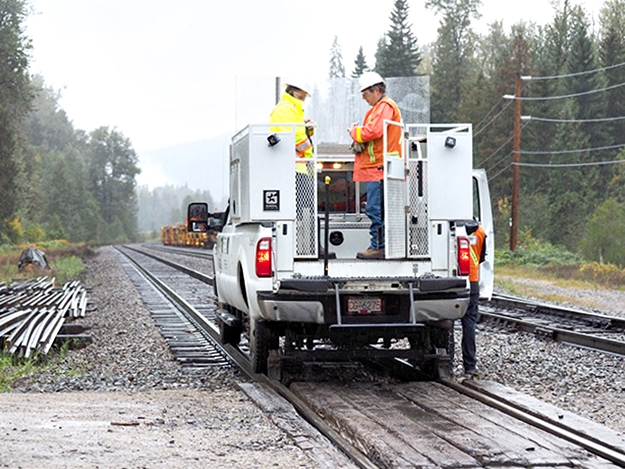
Commentary from a CP employee;
I know some of the people involved in this incident, so I won't name any names involved. Interestingly, the supervisor who was fired was not even hired when I retired in 2005. The firing was noted in the Revelstoke newspaper. (and in the above article as well).
Sometime in early 2015, a westbound freight was approaching Revelstoke, very close to the maximum service hours (12) allowed in the hours of service regulations. There was some pressure to have the train arrive at Revelstoke because of a possible strike deadline.
Greeley is a tiny farming community , which provides road access to the track of the Mountain Subdivision, not possible east or west for several miles. Revelstoke is about eight miles distance to the west.
Over the years, just about every scenario for relieving train crews has played out here in order to avoid the time consuming process of securing the train with handbrakes. Since "extended limits" came into the working agreements, the outgoing crew can be called to relieve the incoming crew. Yard crews can also bring the train in. Also, any qualified employee or supervisor can occupy the operating cab to ensure the train doesn't move (usually road manager, shop foreman etcetera) but I've done it as a yard engineer.
What happened in this case was that the Manager of Operations (modern equivalent to an assistant superintendant) instructed the incoming crew to "cut and run", take the locomotives and several cars to Revelstoke, and leave the rest of the train at Greeley.
He told the crew not to secure the portion of the train to be left at Greeley.
Greeley today is a pair of CTC crossovers in two track territory, but for many years was a CTC controlled siding. There are two private crossings which need to be cut, but they are far enough apart that many trains fit between them.
Greeley is generally flat, with a slight downgrade westbound to the east (less the 1%) and another similar downgrade to the west end. In practical terms, you can park a train here for an indefinite period without handbrakes and it would be unlikely to roll away. However, these are post Lac Megantic days. The unsecured portion of the train in this instance didn't move and I don't know how long it sat there in that state.
What has not been made public information about this incident is the tone of the radio conversation between the manager and the crew. Was threatening or intimidating language used?
Here we get into a grey area. Experience and past practice tells me that when a "direct order" is received from a manager, it will be complied with. However, the law says that such an order can be refused if it poses an immediate danger to other staff and the public. Usually, the wise course is to "do it now and grieve it later".
So here was the dilemma presented to the train crew and RTC. The crew likely knew that the unsecured portion of the train would sit at Greeley without handbrakes, and possibly the RTC did too.
Did the supervisor threaten them in any way over the radio?. What was their response?
What is interesting in this case is that Transport Canada investigated the incident twice, once soon after it happened and again recently.
Did the change in Federal Government have any influence here?. We have all heard of Prime Minister Harper's habit of throwing minor Government officials "under the bus".
Initially, CP transferred the officer to Cranbrook soon after the incident.
The article mentions that the RTC was disciplined, no mention was made of the train crew.
(Via a former St-Luc Diesel Employee whose Name is withheld)
Transport Canada has hit Canadian Pacific Railway with an unprecedented order demanding the company change its freight train line-ups and fatigue-management practices on some runs in British Columbia because they pose "an immediate threat to safe railway operations."
Federal rail safety inspector Todd Horie sent CP a formal letter last In Mid-January identifying working conditions that he says leave crews unable to get proper sleep or to predict their work schedules. The situation "creates excessive fatigue ... at locations on CP within British Columbia, including but not limited to Roberts Bank, Coquitlam and Kamloops," Horie writes.
The Transport Canada order requires CP to remedy the situation immediately by:
Including all travel time from CP rest facilities to train terminals when calculating the length of an employee's on-duty time.
Allowing employees to rest if the train they've been waiting for gets cancelled.
Improving the accuracy of train line-ups so employees can better predict their next on-duty shift
While Canada's freight rail industry has been experiencing a downturn in recent months, the general trend has been toward longer trains and greater volume of goods to keep up with the growing just-in-time delivery demands.
Although the Transport Canada order is specific to that stretch of CP's operations, similar complaints about problems related to employee exhaustion and scheduling have been documented for years. However, the order marks the first enforcement action by Canada's rail regulator to declare such an "imminent threat," CBC's investigation has found.
Rail companies fight new rules to prevent crew fatigue
Freight train drivers report falling asleep on the job
Engineer asked to drive passenger train on two hours' sleep
CP raided a 2nd time over train left with no handbrakes
"CP will immediately comply with the terms of the order but will consider all options and the possibility of work scheduling as it relates to this matter," CP's assistant vice-president of communications, Martin Cej, told CBC news in an emailed statement Friday.
A review of working conditions was prompted by complaints from "multiple crew members" working so-called extended service runs between Kamloops and the Greater Vancouver Area.
In a follow-up statement Monday, CP spokesman Martin Cej said, "Crews are not on call 24/7. Crews have significant and often unutilized opportunities to schedule rest.
"CP has been taking steps to ensure crew members take more rest, but union collective agreements have been a barrier to change."
'Your brain is mush"
A number of locomotive engineers have told CBC News that changes to staffing levels and CP scheduling "Ten years ago, the company cared, but now, everybody is just concerned about money," one CP engineer from Western Canada told CBC News, asking to remain anonymous for fear of being fired.
He said a combination of longer trains, unpredictable schedules and the elimination of the taxis and vans that used to shuttle replacement crews back and forth between terminals are forcing employees to spend longer hours stuck at "away-from-home terminals."
"Our internal clocks are screwed," he said, describing a growing loss of control over when employees work and when they sleep.
Ruling practices are taking their toll and leaving train crews increasingly exhausted.
He said a routine scenario could see him driving a train from his home community to another location between the hours of midnight and 6 a.m. but then having to wait 12 to 24 hours not knowing when he'll be assigned to drive a train back home.
"You get into your away- from-home terminal, say, at 6 a.m. in the morning. Then you go to bed, and you sleep until two o'clock in the afternoon. You get up. You're wondering when you're going to go back to work, And you look on your screen, and it's showing you not out of your away-from-home terminal now until midnight!" he said.
That means he'll be awake for 10 hours before reporting for his next eight-hour shift, leaving him tired and, at times, nodding off at the train controls.
CP earns record profits despite declining freight volumes
CP conductor speaks out about firing
CP encourages office workers to learn to drive trains
"You're fatigued," he said. "You're done. Your brain is mush. You want to go to sleep. You're fighting constantly with your body. Your body is telling you one thing, but you know that on the other hand, you've got to get that train home, 150 miles of track."
CBC News has obtained internal CP crew records from B.C., Alberta, Saskatchewan, Manitoba and Ontario showing crews routinely having "layover times" in excess of 20 hours.
CP Rail has declined to answer questions about its fatigue-management policies. The company has offered to
meet with CBC News but has been unable to arrange an interview time because it is in the midst of merger talks with Norfolk Southern Corp.Audit finds deficiencies
Transport Canada in early 2015 conducted a four-month national audit of CP's formal fatigue management plan, reviewing scheduling records and policy documents and conducting interviews.
Officials found 11 deficiencies and have since instructed CP to adopt "corrective action plans" to fix those problems. However, Transport Canada blacked out large portions of the audit report, which was obtained by CBC News through access to information laws, citing protection of commercial interests.
The department has refused to disclose what the problems were or whether they have been fixed.
Sources familiar with the audit tell CBC that CP's fatigue management practices "are not very robust and lack scientific rigor" - unlike in the airline industry, which has adopted much stricter, more predictable scheduling for employees.
"The rail industry as a whole is not very receptive to this," one government source told CBC News. "They are digging their heels in and sticking their heads in the sand. About 25 per cent of all of CP's train crews have no predictable schedules and are on-call 24/7."
'No teeth'
Transport Canada hired a U.S. expert in 2012 to review C
P's formal fatigue management plan, which has to be filed with the government.Patrick Sherry, executive director of the National Centre for Intermodal Transportation at the University of Denver, concluded the plan was too vague.
In an interview with CBC News, Sherry said Canadian transportation regulators are leading the way in developing models for fatigue management but that the laws to enforce the rules need more teeth
For example, the only fatigue management plan that CP has ever submitted was the one Sherry identified as lacking, which was filed with the government in 2011 and has not been updated since.
"There's a lot of evidence that shows that fatigue, if not properly managed, puts a serious and severe risk for creating operational errors," Sherry said.
"Air traffic controllers, ship's captains, pilots, train drivers, military personnel all have the opportunity to work in a 24/7 environment. We know that if you exceed or if you're up beyond 18, 19 hours, your cognitive efficiency decreases dramatically."
One CP engineer who told CBC that in late 2015, he was on-call or at work every single day for a month said he hopes the new Liberal government will step in and order changes to how CP and CN schedule employees.
"They just better look at this seriously and give Transport Canada the power they require and need to regulate these two railways properly - not [have] the railways telling them what to do," he said. CBC NEWS REPORT
http://www.cbc.ca/news/business/cp-rail-safety-fatigue-1.3406045
THE FULL REPORT HERE:
http://www.documentcloud.org/documents/2692162-TransportCanadaRailSafety-LetterofOrder.html
CP RCL Implementation:
CP is now increasing productivity and efficiency in rail yards by implementing remote-controlled locomotives (called RCL). A conductor operates the R/C equipped GP38-2 locomotive from the ground to switch out rail cars, instead of relying on an engineer inside the cab, conductors and switch-crew members can now perform this work on the ground. CP is now implementing this technology. CP spent $8 million in 2014 to install remote control equipment in over 50 locomotives for over 100 work assignments in their network. Then RCL implementation now continues in 2016. CP has reduced many yard jobs, with the goal to save $12 million per year, by implementing remote control operations now and continuing over 2016. Some of CP's main yards are already implementing the latest RCL operation, using their newest R/C modified GP38-2 fleet. The majority of these modified units are being done at Cadrail in Montreal, and at NRE in Silvis, IL. (Joe Ferguson Photo)
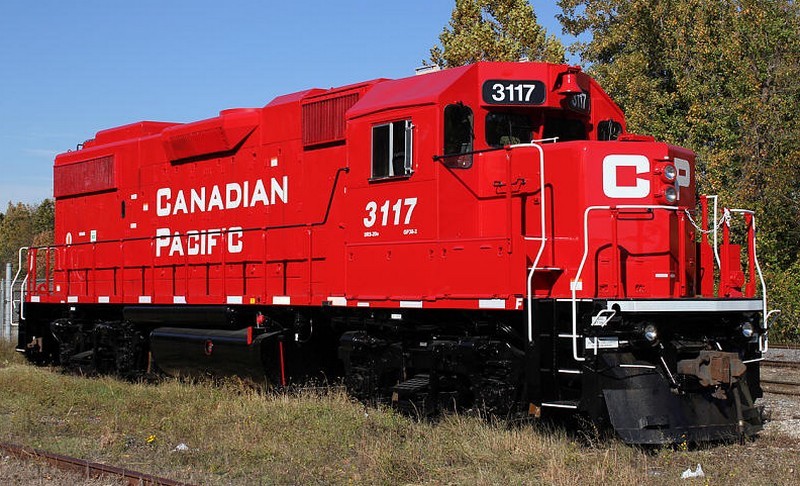
CP PHOTOS
Cp 242 rolls through Zorra Ontario with CEFX 1036 CSX 3010 and CP 2288 as the Sun come sout just at the right time. Jan 29 2016
Walter Pfefferle caught CP 2222 and CP 3061 working in the CP Woodstock Yard Jan 13 2016
A pair of GP20C-ECO's, CP 2259 and 2252 crawl out of Woodstock with a 50 car train at Hwy 2 in Woodstock Ontario on January 22nd, 2016.
On a cold gray day, Walter Pfefferle snapped CP 255 with CP 6262, DME 6090, CP 6255, 9584, 8864 and 2264 crossing over Hwy 2 at Woodstock, Ontario January 2nd, 2016.
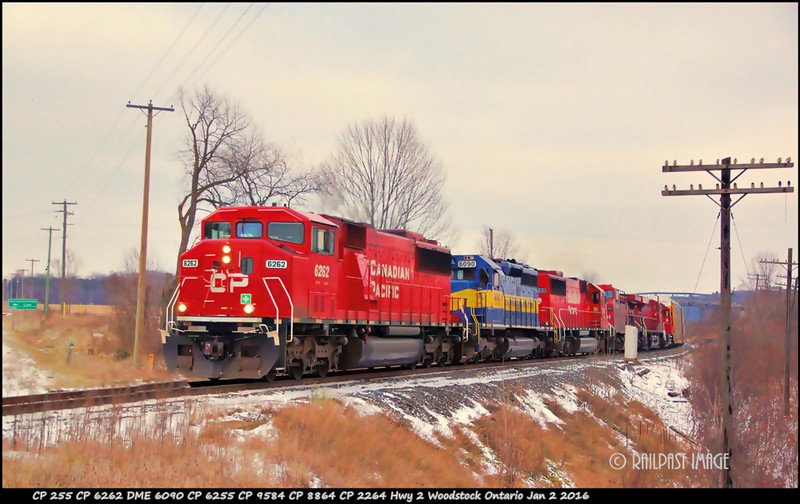
On January 24th, Kenneth Borg clicked CP T-27 making a set out at NS Oakwood Yard in Melvindale, MI with a trio pf former Soo Line SD60 units CP 6242, 6255, and 6221.
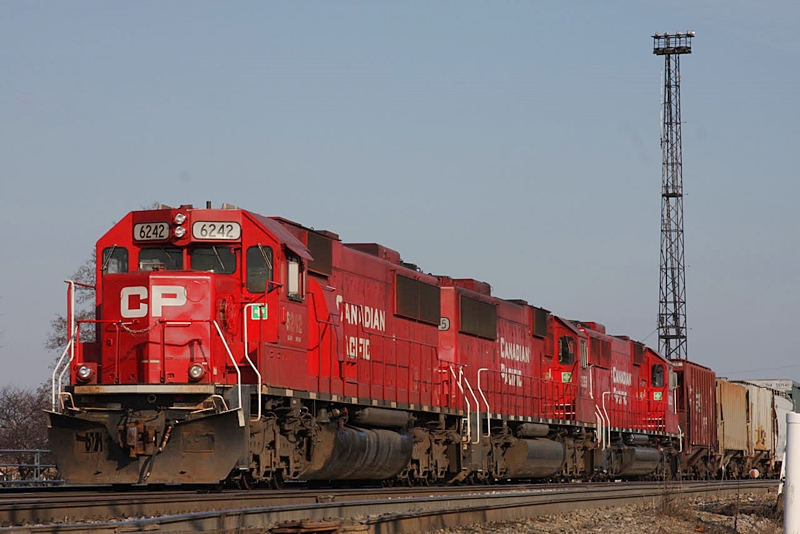
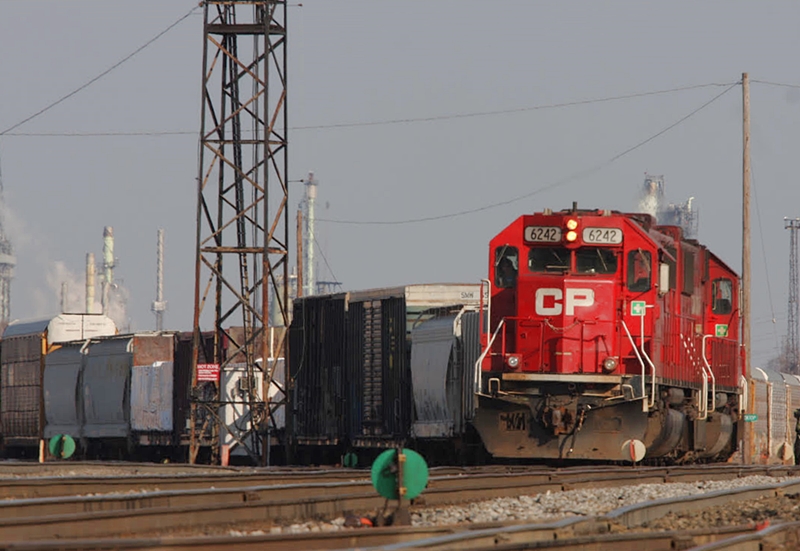
The day before Ken clicked NS train #171 westbound at Monroe Blvd in Taylor, MI on January 23rd, with NS 2510 and 9548.
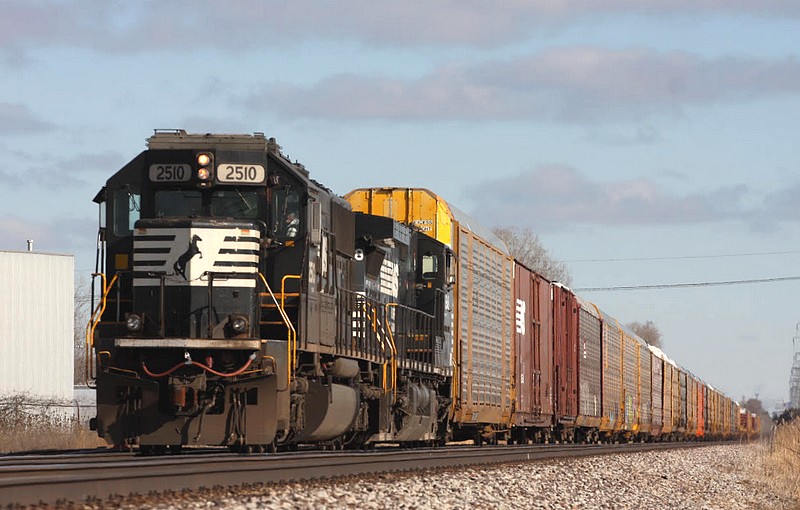
David Maiers reported one of the newest ECO rebuilds (CP 5021)
making its way up to Saskatoon, SASK in mid-December 2015, a rarity in these
parts! He also noted there are plenty of unrebuilt SD40-2s still around on
CP's northern secondary mainline. Witness SD40-2's 5961 and 5909 switching the
Bunge canola processing plant at Harrowby, Manitoba on CP's Bredenbury
Subdivision on January 4th, 2016. While new 5000 series ECO rebuilds enter the
roster, the old guard continues to work hard. To the west, at the crew change
point of Bredenbury, Saskatchewan, a half dozen SD40-2s were idling awaiting
their next switching assignments.
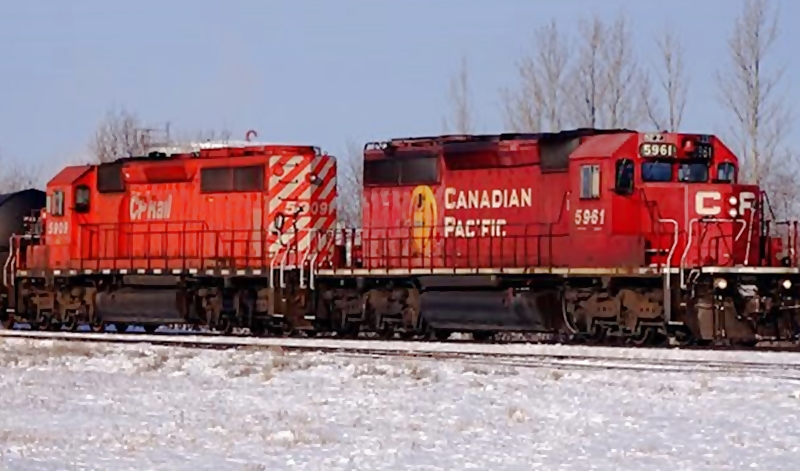
Ed Creechan believes it helps to be a little crazy, otherwise why would a sane person chase a train through town on one of the coldest days of the year. On January 13th he really couldn't help himself after spotting this westbound CP freight rolling through Hamilton Ontario with a trio of Kansas City Southern locomotives in the CP consist! We would agree with him! The KCS units included SD70MAC 3929 and SD70ACE 4116.
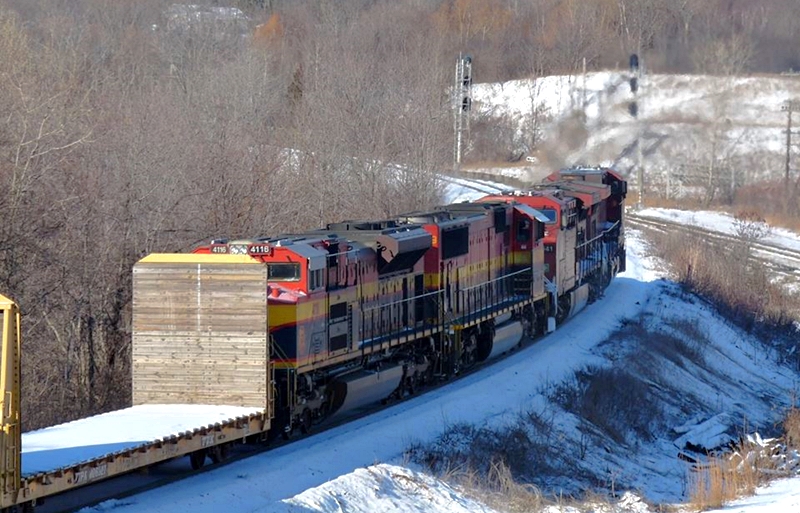
What's at St-Luc? On January 23rd, 2016 on a visit to CP St-Luc Yard in Montreal, QC Luc Lanthier caught the following units:
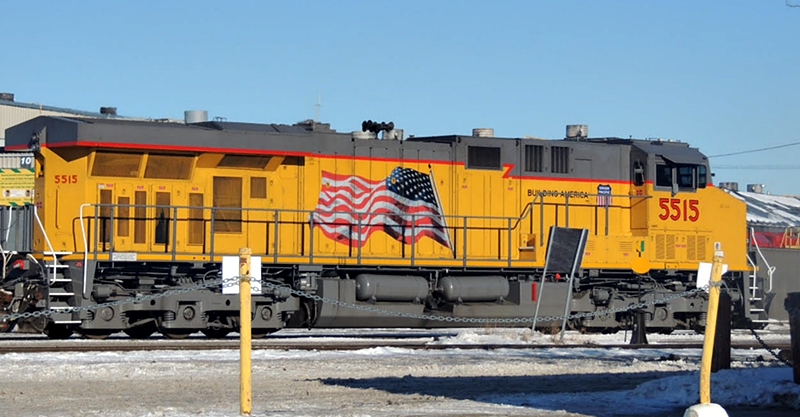
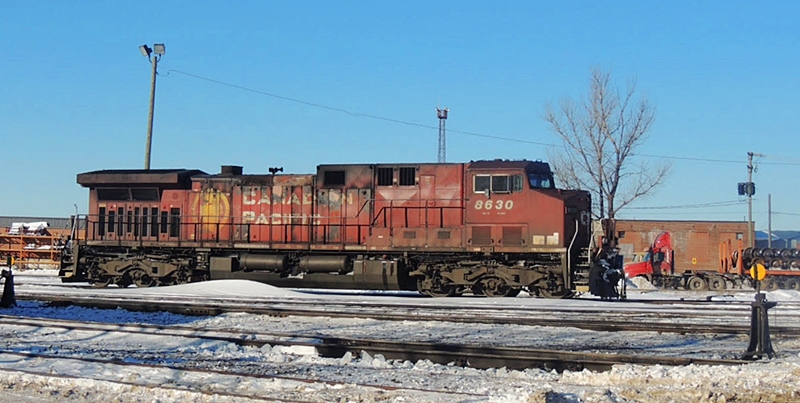
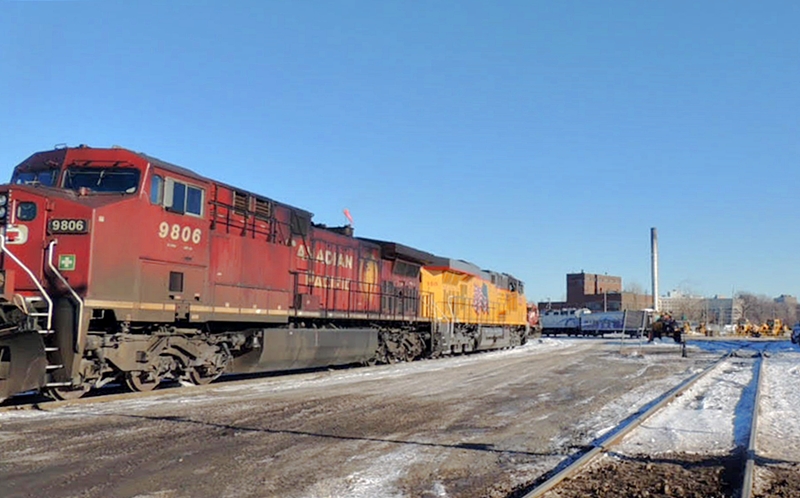
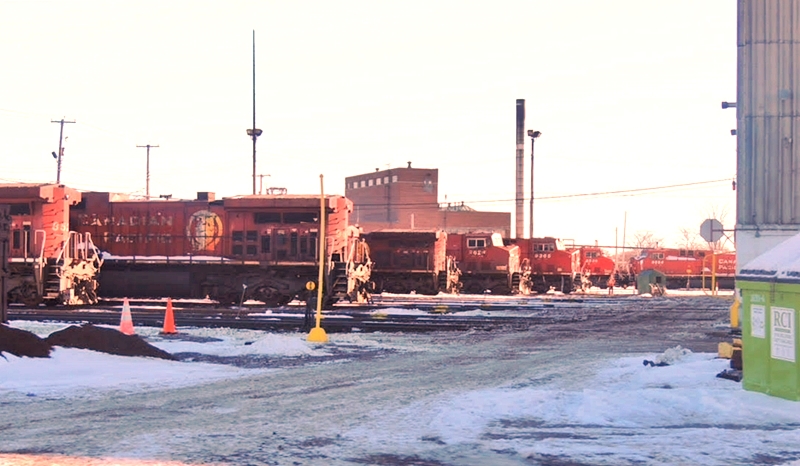
On January 8, 2016 at 11:30am, the following units
were noted at the St-Luc Yard in Montreal, QC:
CP 2251, 2256, 2279, 2282, 2285, 3024, 3038, 3039, 3047, 3048, 3053, 3064
CP 3089, 3099, 3101, 3119, 3129, 3130, 3134, 4508, 4653, 7309, 7310
CP 5763, 5773, 5788, 5795, 5833, 5903, 5919, 5928, 5942
CP 5946, 5949, 5953, 5993, 6017, 6031, 6038, 6613
CP 8500, 8501, 8508, 8510, 8529, 8538, 8542, 8548, 8554, 8557, 8580, 8624
CP 8627, 8714, 8723, 8737, 8801, 8823, 8860
CP 9520, 9521, 9530, 9539, 9545, 9555, 9558, 9570, 9571, 9573, 9576, 9577, 9581
CP 9595, 9598, 9599, 9608, 9629, 9641, 9649, 9655, 9660, 9671, 9682, 9709, 9711
DME 6080
SOO 4429
Train 142 - CP 9775/9781 was nearby heading to Hochelaga, QC with a Port
Train.
Departure track: Train 119 - CP 9750/8700 D Smiths Falls, ON at 17:20pm
Some of the AC4400CW's and SD40-2's on this list are currently in storage.
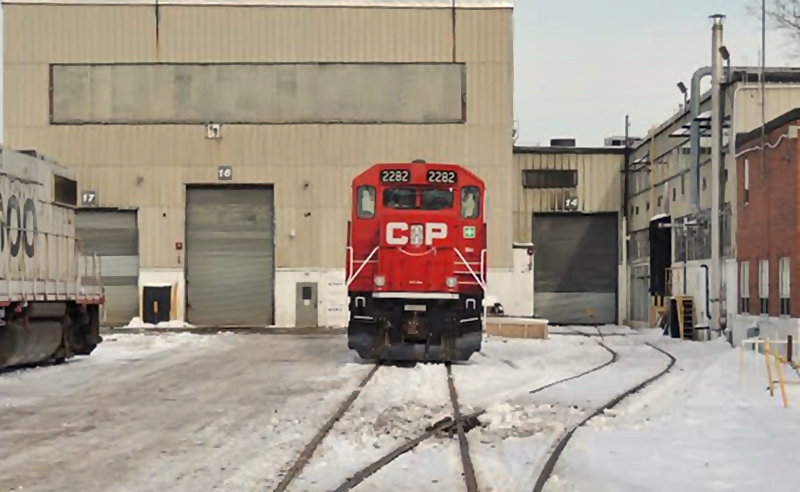
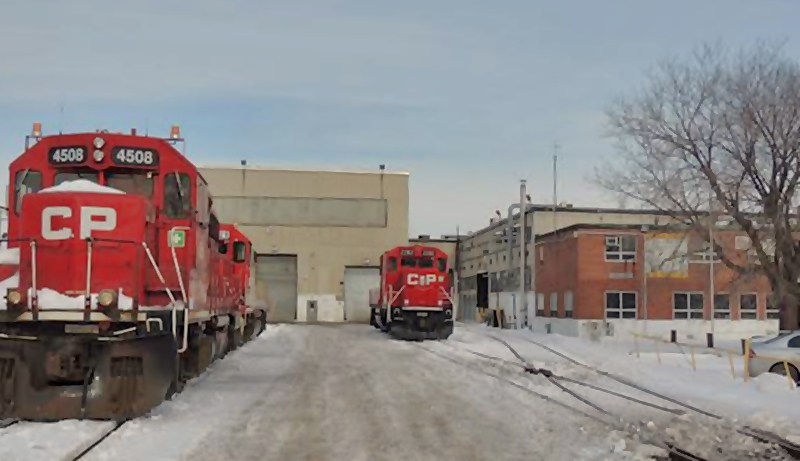
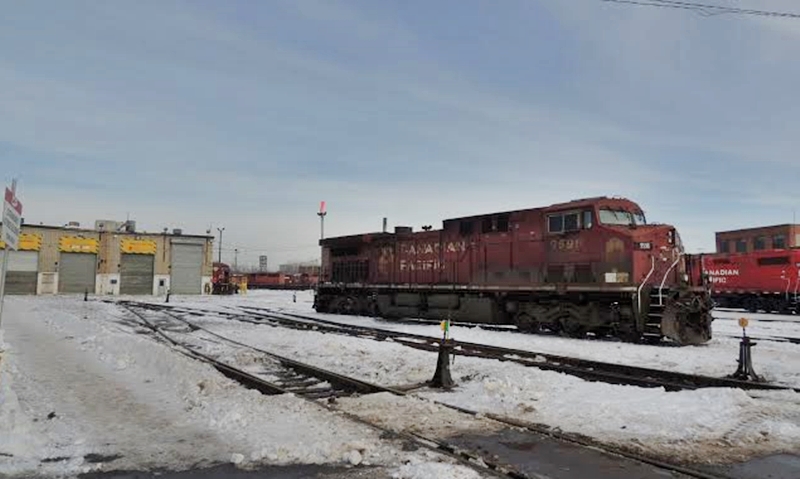
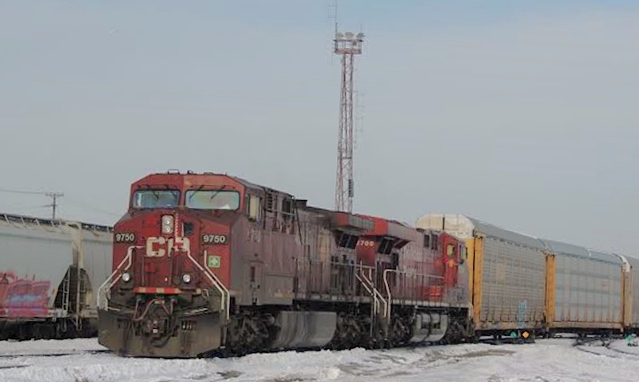
CP VIGNETTES
Sponsored by Old Time Trains
On Aug 21 2008 CP 8249 and CP 8231 heading to St Thomas ON rolled around the curve at Putnam ON only to see a tractor trailer loaded with landscaping stone stopped on the tracks. The crew threw the train into emergency and hit the deck. CP 8249 crashed into the truck derailing it and taking 8231 with it. Thankfully nobody was hurt and both units were back in service not long after the accident.
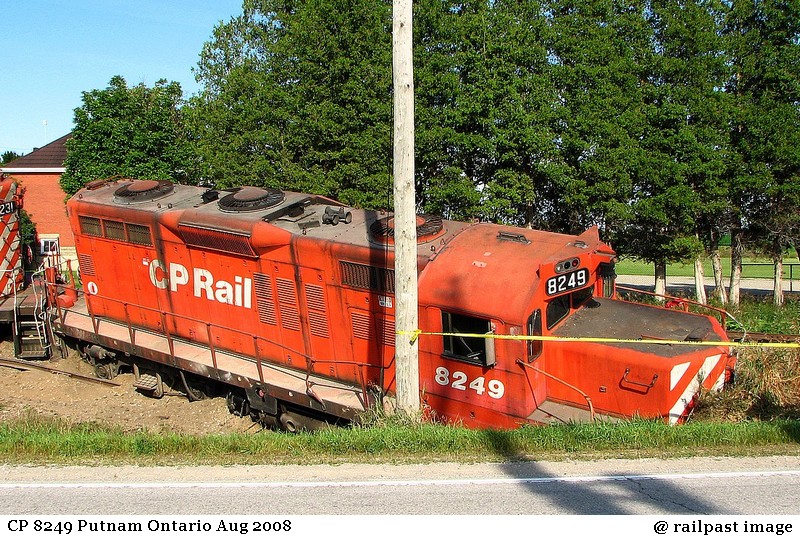
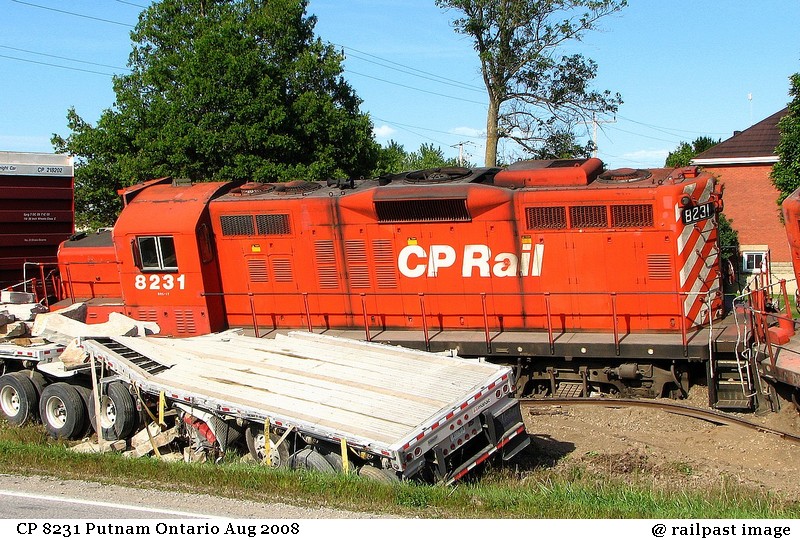
One of Ron Visockis (and Our) favorite Locos was the
MLW-built FPA-2
Ron shot CP 4094 in CP RAIL Action Red sitting at the St-Luc Diesel Shop in
Montreal, QC on Christmas Day 1972, awaiting her next assignment.
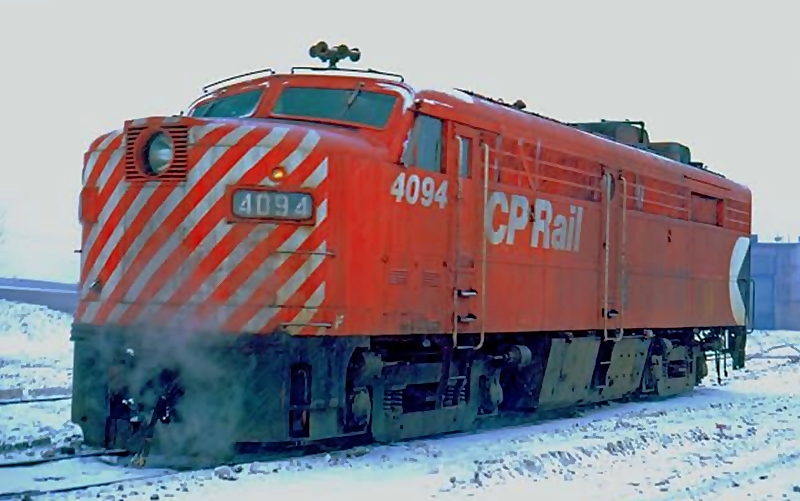
Bill Grandin shot VIA F9B 6653 clearly showing her CP Rail heritage at Mimico (Toronto, ON), on June 23rd, 1988. My buddy Bruce Chapman added that VIA 6653 was built as CP 1905 originally, became a freight unit CP 4477. VIA bought it from CP and renumbered it to 1964, and then Point St-Charles overhauled it and it became VIA 6653.
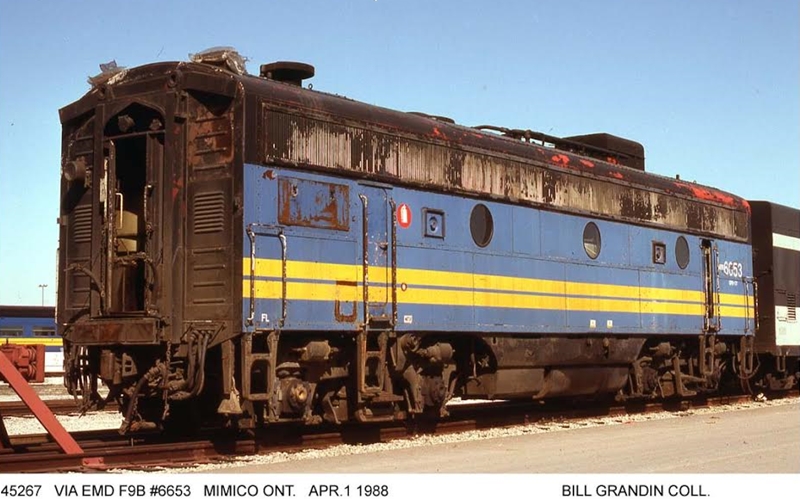
Mark Paterson caught CP SD40 5521 easing up past the station at Galt Ontario back in 1999. Built at the GMD London plant back in 1966, this old GMD is still in operation today as CITX 3082.
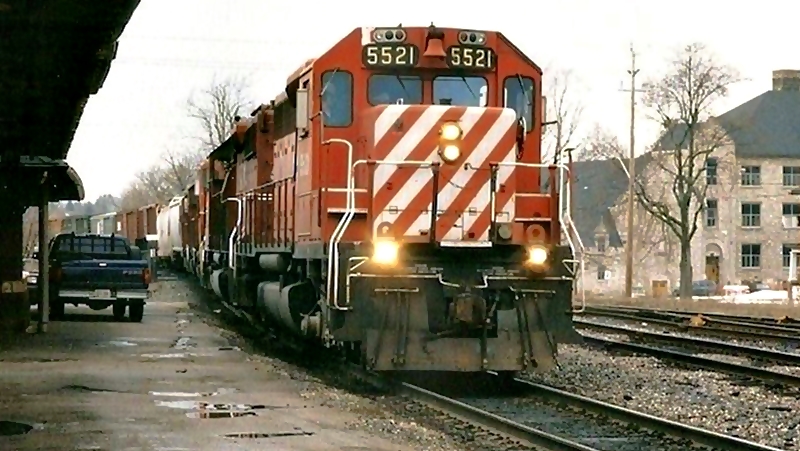
These two SW1200RS switchers were not normally seen in Calgary, AB. They were shot at the Alyth Diesel Shop on the morning of December 9th, 2003. The photographer believes they were being given a once over before being disposed of. At this time CP was selling off many of their SW1200RS SD40-2's and Slugs.
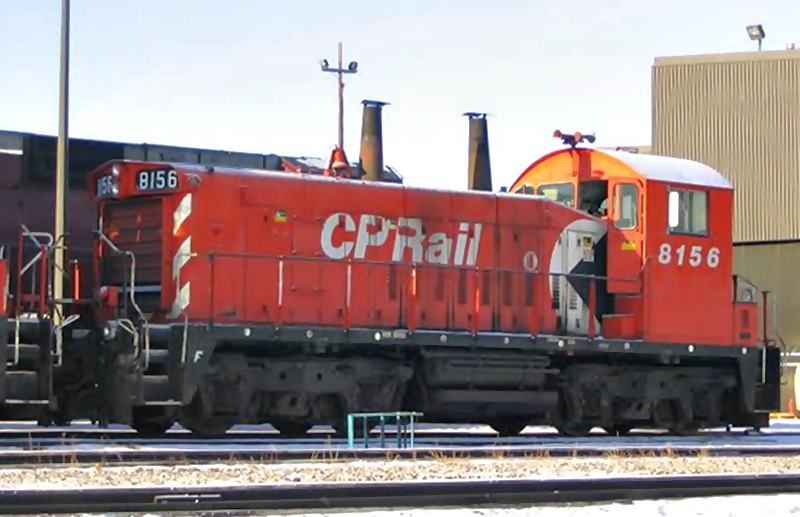
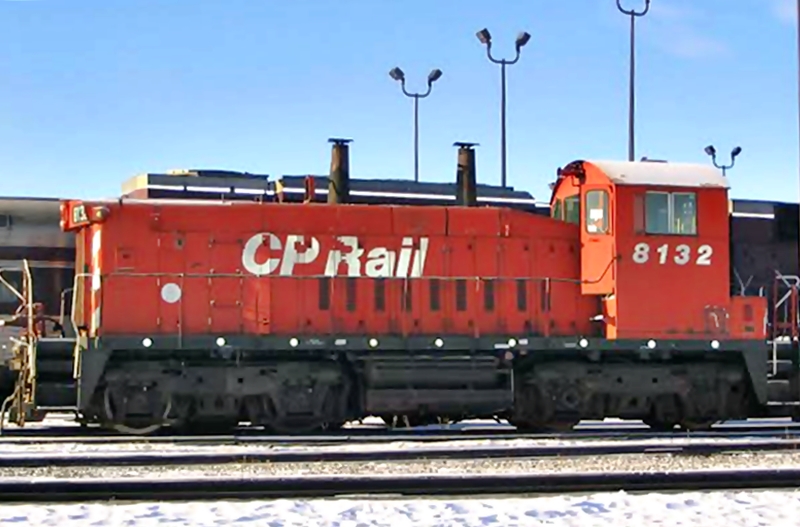
The LIFE and DEATH of CPR E8A 1801
Bruce Chapman sent us this fabulous shot by Bob Sandusky of CPR E8A 1801 on April 5th, 1958, leading Train #10 at Renfrew, Ontario. Take note of all the "Head end" Express cars! This #10, and his counterpart westbound #9, ran from Montreal to Sudbury. At Sudbury, they connected with #6 east Vancouver/Toronto and #5 west Toronto to Vancouver. #10 stopped everywhere, and it picked up money remittances from all the open stations on a manned express car by a guy who carried a gun. When the train came off in September 1959, local railway agents had to go to a local bank and deposit the money in a CPR account. LBC
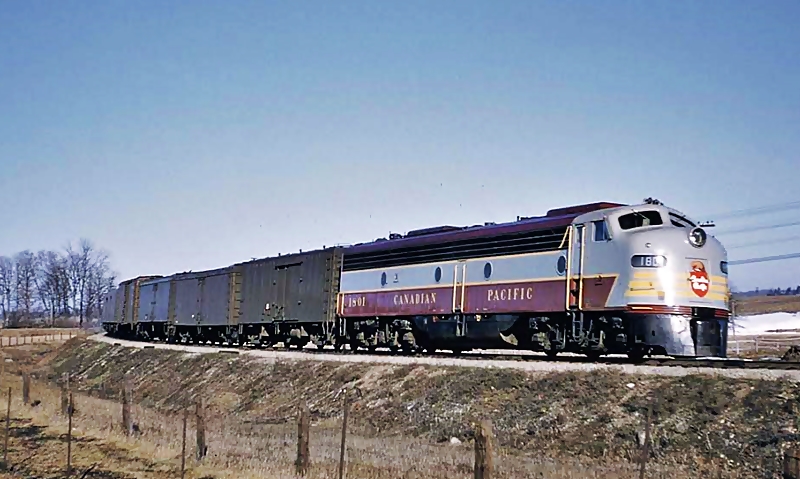
On December 28th, 1968 CP train No. 154 with six passenger cars struck head-end of Extra 8787 West, with two D.E. units and 44 empties. It was stopped on Main Track 10 car lengths east of the west switch at Lachevrotiere, QC (Mileage 117.6) on the Quebec Subdivision), causing damage of $107,000 and injuries to three employees and 44 passengers. Extra 8788 West arrived at the east switch Lachevrotiere between 20:07 and 20:09, and it was the intention to pull into siding to clear No. 154, which was due at this point at 2025.
Head-end trainman was not able to line the switch for the siding due to ice and snow, and it was decided to cut engine off to take Flagman westward to protect against No. 154. Flagman was taken westward to a point two or three pole lengths west of Bridge mileage 116.4 where he states that torpedoes and fuses were placed. The Flagman returned with the engine and dropped him off at West Switch, where he intended to clear switch of snow, line it for siding, stop No. 154 on arrival and put it into siding. The engine returned to the train, coupled on and moved westward on main track to a point about 10 car lengths east of the west switch and stopped at 20:35. No. 154 was running 21" late and approached curve at mileage 115.9 at about 65 m.p.h. Speed was reduced to 35-40 m.p.h. east of Bridge mileage 116.4.
Engineman observed the headlight of an engine and made an emergency application of the brake, but train could not be stopped before colliding with the head-end of CP Extra 8787 West at 20:45. Just after emergency application of the brake was made, Engineman and Fireman observed that the aspect of the approach signal mileage 116.6 Lachevrotier Diamond immediately west of west switch was at stop. The evidence indicates that neither head-end crew of No. 154 nor the head-end crew of Extra 8787 West heard any explosions of torpedoes. The Conductor and rear Trainman, who remained in Van, were advised by radio of the arrangement to take the Flagman out to protect against No. 154, and did not take any action or make any protest.
Rules 291, 87, 99, 101 and 106 U.C.O.R. were violated. The weather on that day was stormy, and poor visibility, at a temperature of 10F above Zero.
Sadly, the collision was too much for the CP E8 #1801 and was retired with a bent frame. Here is a VIDEO showing the aftermath of the collision: https://www.youtube.com/watch?v=pTC-A0d4Vn4
This additional text is from Bruce Chapman concerning CP's only three E-8's, (CP 1800-1801-1802), that used to run through and into Ottawa many years ago.
I made many trips behind those three diesel locomotives, and one trip that comes to mind happened behind 1802 on January 29th, 1962.
Train 233 was a daily passenger train leaving Montreal's Windsor Station at 0800 with six regular stops enroute to Ottawa. The train had one or two trains to meet that required taking the siding, being in the inferior direction, and arrived at Union Station (downtown) at 10:35. This was a very popular train, especially with people from the business world and Members of Parliament, etc. They could leave Montreal in the morning, arrive in Ottawa, do their business and return at 1700, arriving at Montreal at 19:15. There was good accommodation, with dining and parlour car service.
On the date in question, I was the conductor with Armand Richer the engineer. We had a five-car train consisting of baggage car 4490, coaches 2287 and 2247, cafe-parlour 6672 and parlour 6664.
The trip was uneventful until we were stopped unexpectedly by the train order signal at St. Eugene (Ontario). After making the stop at the station, we were advised by the agent that Rigaud (Quebec) had reported smoke coming from the wheel area of our engine.
On examination, we found that the independent brake had been on enough to turn the wheels white hot. Several applications and releases of the engine brakes were made to see if they were functioning properly. A couple of times when the brakes were released, the shoes did not move free of the wheels, especially on wheel "L-6", the trailing wheel on the trailing truck on the fireman's side.
To move the shoes free of the wheels, I used one of the section men's snow shovels to hit the brake shoe, When some of the snow that was on the shovel struck the hot wheel, it started to sizzle. After we assured ourselves that the brakes were operating properly, we departed St. Eugene several minutes late. This was of particular concern to the passengers, especially those Members of Parliament who had to be in the House for 11:00 and the business people who had appointments.
On this particular morning, the weather was sunny and very cold. It was also a Monday. After passing Navan (Ontario), and travelling about as fast as the 1802 could turn a wheel, along about mileage 78 or 79 (M&O Subdivision), there was an emergency application of the brakes. Before we got stopped at mileage 81, we had travelled approximately two miles around a long left-hand curve and over the angle crossing just east of Blackburn siding. After coming to a stop and making an inspection, we found about a third of the wheel, "L-6" on the 1802 was broken and the piece was missing. This, you will recall, was the same wheel we had examined at St. Eugene. When the wheel had broken, the piece apparently flew up and broke the train line on the baggage car and caused the emergency application of the brakes.
The portable telephone was immediately connected to the poles and the dispatcher advised of our problems. Arrangements were made to transfer the passengers to Ottawa by taxis and bus. Another engine and the shop staff from Ottawa West were brought out to move the 1802 into the siding at Blackburn and take our train into the station.
In order to move the 1802, a tie was placed on top of the rail and the broken part of the wheel rested on the tie and the engine was "skidded" into the siding. After we had left Blackburn, the skidding process was continued all the way over to the Ottawa West shops. This was a long slow operation that lasted until late into the evening. I was told that by the time they reached the shops, there was only the hub of the wheel left!
Our train finally arrived in Ottawa, sans passengers, at 1330. There, we were advised by the Superintendent how lucky we were that we didn't take the ditch. The section men had examined the track and found several broken rails starting at mileage 78 and at least three were sticking up in the air in such a fashion that it was unbelievable how the train was able to pass over them. This is one time that were fortunate to have a unit with a six-wheel truck and the trailing pair of wheels. If it had been a four-wheel truck, we would no doubt have ended up over in Le Mer Bleu.
Of course, at the ensuing inevitable investigation, it came out that the crew was shoveling snow on the wheel to cool it off. When it was explained exactly what had happened, the matter was dropped. It was also revealed that the engineers had been having problems with the independent brake slipping on, and had been booking this condition for several trips. Needless to say, this was promptly rectified.
In closing, I found something else of note when checking my records. The engine that was sent out to haul our train into Ottawa was the 8558 (RS-10). It so happens that both of these derelicts, 8558 and 1802, ended up on the VIA engine roster. (Both have since been retired).
(BRUCE CHAPMAN) (Photos by Ron Viockis, Robert O'Shaughnessy, and Jim McCrae with thanks).


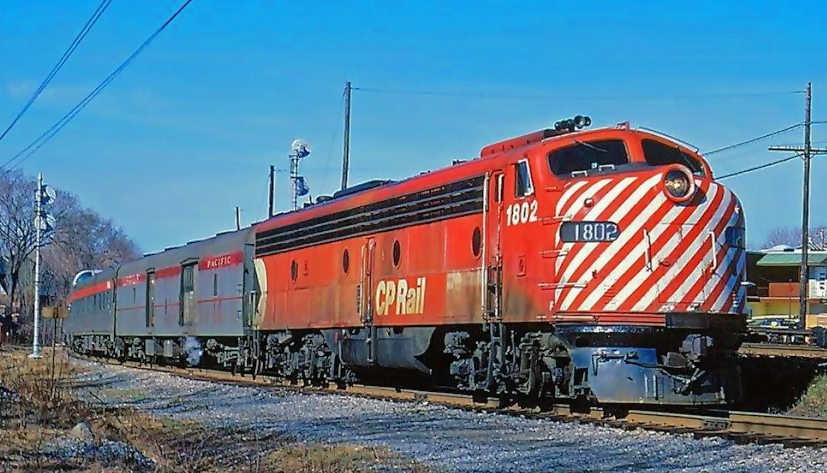
Canadian National Canadian Pacific VIA Rail AMT/GO/WCE Canadian Locomotive Shops Regionals & Shortlines
Tourist Lines & Museums South Of The Border Modellers Corner Letters To The Editor Your Comment Welcome
© CRO February 2016





